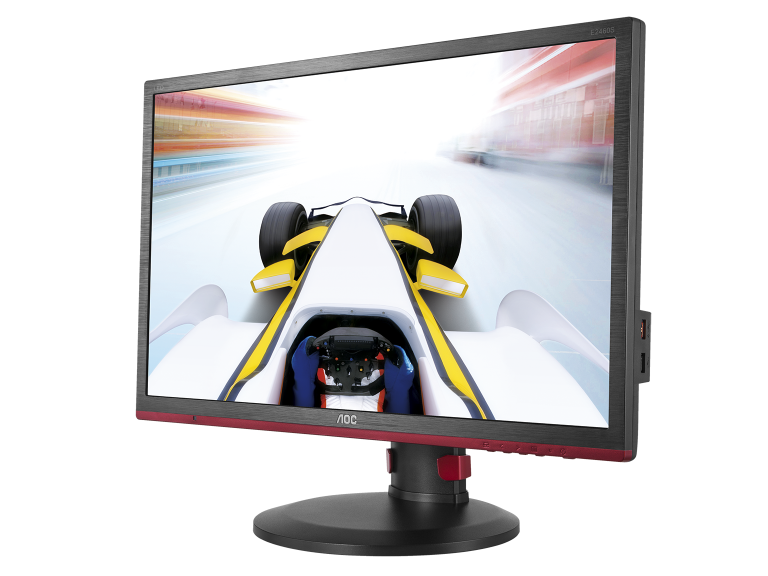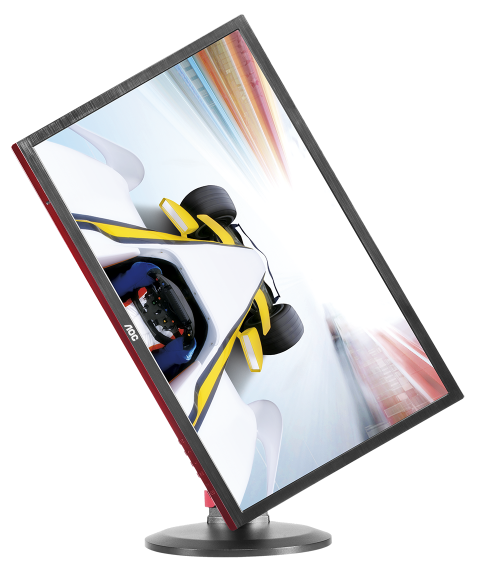AOC's New Gaming Monitor Does 144Hz
This monitor has a refresh rate of 144 Hz.
This week, display maker AOC launched a new monitor designed with gamers in mind, the AOC G2460PQU. The 24-inch panel promises crystal clear images, reduced input lag and more frames per second thanks to its 144 Hz refresh rate and its 1 ms GTG response time.
"With 144 Hz frame rate, you get those critical missing images on the screen which shows enemy movement in ultra-smooth motion so you can easily target them," reads the product page. "You won't have to put up with input lag and screen tearing with this AOC gaming display."
According to the company, the AOC G2460PQU allows users to switch between seven different screen sizes: 17-inch Pillar Box (5:4), 19-inch Pillar Box (5:4), 19-inch Widescreen (16:10), 21.5-inch Widescreen (16:9), 22-inch Widescreen (16:10), 23-inch Widescreen (16:9) and 24-inch Widescreen (16:9). There's also a four-way adjustable stand so that the user can change the monitor height by 130 mm, swivel left and right, tilt the screen angle, and pivot 90 degrees to landscape or portrait view.
The specs show that the monitor has a dynamic contrast ratio of 80,000,000:1, a typical brightness of 350 cd/m2, up to 16.7 million colors and a 1920 x 1080 resolution. The panel also provides a number of ports including VGA, DVI-Dual Link, HDMI, DisplayPort, and four USB 2.0 ports, one of which can charge a connected smartphone or other devices.
"The VESA-compatible monitor can also be unscrewed from the stand and mounted to the wall," reads the company's PR. "Button controls are located on the underside of the display and dual USB ports are conveniently located on the right side of the panel. The monitor's back also has a hook to keep cables together and organized."
Obviously, the 144 Hz refresh rate is this display's biggest selling point. However, there are a number of gamer-focused monitors on the market with 1 ms GTG response times, making it hard to settle on just one model. These include BenQ's 24-inch RL2460HT, which features a 1920 x 1080 resolution, a 12,000,000:1 dynamic contrast ratio, an adjustable rotating stand and more for a lower price. Asus also has a line of gaming monitors with 144 Hz refresh rates and 1 ms response times.
The AOC G2460PQU is now available for $399.99 at national CE retailers. For more information about AOC's new monitor, head here.
Get Tom's Hardware's best news and in-depth reviews, straight to your inbox.

Kevin Parrish has over a decade of experience as a writer, editor, and product tester. His work focused on computer hardware, networking equipment, smartphones, tablets, gaming consoles, and other internet-connected devices. His work has appeared in Tom's Hardware, Tom's Guide, Maximum PC, Digital Trends, Android Authority, How-To Geek, Lifewire, and others.
-
soccerplayer88 "You won't have to put up with input lag and screen tearing with this AOC gaming display."Reply
Lolwut? Do these guys at AOC not know what V-Sync is? The only monitor that can handle v-sync off without screen tearing is the ASUS VG248QE with the G-Sync kit from Nvidia and those are sold out everywhere (as well as the kits).
Claiming a monitor eliminates screen tearing when it's all reliant on the GPU settings... *shakes head* -
PEJUman Reply"You won't have to put up with input lag and screen tearing with this AOC gaming display."Lolwut? Do these guys at AOC not know what V-Sync is? The only monitor that can handle v-sync off without screen tearing is the ASUS VG248QE with the G-Sync kit from Nvidia and those are sold out everywhere (as well as the kits).Claiming a monitor eliminates screen tearing when it's all reliant on the GPU settings... *shakes head*
AOC is correct, at 144 Hz you technically will be able to run any frame rate up to 144 Hz without tearing & lag.V-SYNC tells the GPU to WAIT FOR THE NEXT REFRESH, G-SYNC tells the display to WAIT FOR THE NEXT FRAME (both will add lag).Not that many GPUs can run faster than 144 Hz @ 1080P with all the eye candy turned on. -
dimar I use VirtuMVP 2 virtual vsync. No tearing, no lag, works with all games.Can Tomshardware do sort of analysis comparison between nVidia's new G-Sync and Lucid's Virtual vsync?Reply -
toddybody Reply
Nope. Frame tearing comes from the output not being in sync, or a multiple of the monitor's refresh rate. So, if Im outputting a game at 111 FPS...its going to tear frames. G-Sync actually changes the monitor's refresh rate to match the card output, natively."You won't have to put up with input lag and screen tearing with this AOC gaming display."Lolwut? Do these guys at AOC not know what V-Sync is? The only monitor that can handle v-sync off without screen tearing is the ASUS VG248QE with the G-Sync kit from Nvidia and those are sold out everywhere (as well as the kits).Claiming a monitor eliminates screen tearing when it's all reliant on the GPU settings... *shakes head*
AOC is correct, at 144 Hz you technically will be able to run any frame rate up to 144 Hz without tearing & lag.V-SYNC tells the GPU to WAIT FOR THE NEXT REFRESH, G-SYNC tells the display to WAIT FOR THE NEXT FRAME (both will add lag).Not that many GPUs can run faster than 144 Hz @ 1080P with all the eye candy turned on. -
Christopher Shaffer Reply
Nope. Frame tearing comes from the output not being in sync, or a multiple of the monitor's refresh rate. So, if Im outputting a game at 111 FPS...its going to tear frames. G-Sync actually changes the monitor's refresh rate to match the card output, natively."You won't have to put up with input lag and screen tearing with this AOC gaming display."Lolwut? Do these guys at AOC not know what V-Sync is? The only monitor that can handle v-sync off without screen tearing is the ASUS VG248QE with the G-Sync kit from Nvidia and those are sold out everywhere (as well as the kits).Claiming a monitor eliminates screen tearing when it's all reliant on the GPU settings... *shakes head*
AOC is correct, at 144 Hz you technically will be able to run any frame rate up to 144 Hz without tearing & lag.V-SYNC tells the GPU to WAIT FOR THE NEXT REFRESH, G-SYNC tells the display to WAIT FOR THE NEXT FRAME (both will add lag).Not that many GPUs can run faster than 144 Hz @ 1080P with all the eye candy turned on.
As an owner of both a VG248QE and the G-Sync module I installed after the fact, I can tell you with 100% certainty that simply running at 144Hz doesn't eliminate screen tearing, even in games where I'm pushing over 144 FPS. What DOES eliminate it as well as make the motion fluid as hell is 144Hz/120Hz + G-Sync.
Also, G-Sync doesn't simply tell the display to wait for the next frame. It monitors the frame rate as sent by the card WITH V-SYNC OFF (it's one or the other, G-Sync or V-Sync, not both) and matches the refresh rate accordingly.G-Sync is as real-time as and frame display tech gets. You see what the card renders when it's rendered, within (theoretically) 1ms; realistically w/in 10ms.
V-Sync forces the FPS to match a multiple/factor of the refresh rate (60Hz = 60/30/15 FPS). It doesn't sync the refresh rate to the frame rate. If your refresh rate is significantly out of sync with your FPS, you'll experience tearing due to a partial frame being displayed mid-refresh.
So in short, buy G-sync.
Also, this is overpriced as hell.
(PS - Tom's your formatting comments is still all $#%$ed up using mobile and Chrome - I had to go to the forums to get the spacing right. Otherwise it looks like this:
There is no spacing.Between sentences and paragraphs.Please hire a decent developer.Maybe someone who knows HTML and CSS.Thanks.) -
Bondfc11 Reply
Long quote to just say - I agree with the last sentence completely (and G-Sync is incredible).
As an owner of both a VG248QE and the G-Sync module I installed after the fact, I can tell you with 100% certainty that simply running at 144Hz doesn't eliminate screen tearing, even in games where I'm pushing over 144 FPS.What DOES eliminate it as well as make the motion fluid as hell is 144Hz/120Hz + G-Sync.Also, G-Sync doesn't simply tell the display to wait for the next frame. It monitors the frame rate as sent by the card WITH V-SYNC OFF (it's one or the other, G-Sync or V-Sync, not both) and matches the refresh rate accordingly.G-Sync is as real-time as and frame display tech gets. You see what the card renders when it's rendered, within (theoretically) 1ms; realistically w/in 10ms.V-Sync forces the FPS to match a multiple of the refresh rate. It doesn't sync the refresh rate to the frame rate. If your refresh rate is significantly out of sync with your FPS, you'll experience tearing due to a partial frame being displayed mid-refresh.So in short, buy G-sync.Also, this is overpriced as hell.
Nope. Frame tearing comes from the output not being in sync, or a multiple of the monitor's refresh rate. So, if Im outputting a game at 111 FPS...its going to tear frames. G-Sync actually changes the monitor's refresh rate to match the card output, natively."You won't have to put up with input lag and screen tearing with this AOC gaming display."Lolwut? Do these guys at AOC not know what V-Sync is? The only monitor that can handle v-sync off without screen tearing is the ASUS VG248QE with the G-Sync kit from Nvidia and those are sold out everywhere (as well as the kits).Claiming a monitor eliminates screen tearing when it's all reliant on the GPU settings... *shakes head*
AOC is correct, at 144 Hz you technically will be able to run any frame rate up to 144 Hz without tearing & lag.V-SYNC tells the GPU to WAIT FOR THE NEXT REFRESH, G-SYNC tells the display to WAIT FOR THE NEXT FRAME (both will add lag).Not that many GPUs can run faster than 144 Hz @ 1080P with all the eye candy turned on. -
PEJUman Reply
As an owner of both a VG248QE and the G-Sync module I installed after the fact, I can tell you with 100% certainty that simply running at 144Hz doesn't eliminate screen tearing, even in games where I'm pushing over 144 FPS. What DOES eliminate it as well as make the motion fluid as hell is 144Hz/120Hz + G-Sync.Also, G-Sync doesn't simply tell the display to wait for the next frame. It monitors the frame rate as sent by the card WITH V-SYNC OFF (it's one or the other, G-Sync or V-Sync, not both) and matches the refresh rate accordingly.G-Sync is as real-time as and frame display tech gets. You see what the card renders when it's rendered, within (theoretically) 1ms; realistically w/in 10ms.V-Sync forces the FPS to match a multiple/factor of the refresh rate (60Hz = 60/30/15 FPS). It doesn't sync the refresh rate to the frame rate. If your refresh rate is significantly out of sync with your FPS, you'll experience tearing due to a partial frame being displayed mid-refresh.So in short, buy G-sync.Also, this is overpriced as hell.(PS - Tom's your formatting comments is still all $#%$ed up using mobile and Chrome - I had to go to the forums to get the spacing right. Otherwise it looks like this:There is no spacing.Between sentences and paragraphs.Please hire a decent developer.Maybe someone who knows HTML and CSS.Thanks.)
Nope. Frame tearing comes from the output not being in sync, or a multiple of the monitor's refresh rate. So, if Im outputting a game at 111 FPS...its going to tear frames. G-Sync actually changes the monitor's refresh rate to match the card output, natively."You won't have to put up with input lag and screen tearing with this AOC gaming display."Lolwut? Do these guys at AOC not know what V-Sync is? The only monitor that can handle v-sync off without screen tearing is the ASUS VG248QE with the G-Sync kit from Nvidia and those are sold out everywhere (as well as the kits).Claiming a monitor eliminates screen tearing when it's all reliant on the GPU settings... *shakes head*
AOC is correct, at 144 Hz you technically will be able to run any frame rate up to 144 Hz without tearing & lag.V-SYNC tells the GPU to WAIT FOR THE NEXT REFRESH, G-SYNC tells the display to WAIT FOR THE NEXT FRAME (both will add lag).Not that many GPUs can run faster than 144 Hz @ 1080P with all the eye candy turned on.
G-SYNC lag = 1/'current FPS' i.e. the time it takes to render a full frame vs. just rendering the partially updated segment.
V-SYNC lag = 1/60 or 1/30 or ... i.e. the time it takes for the screen to refresh.
both are LAG, but G-SYNC allows you to dip to smaller ms delay.
On powerful GPUs it means G-SYNC is faster than V-SYNC.
On weak GPU.... it does not matter since <60 FPS sucks.
Just as G-SYNC + fast GPU allows the lag to drop into in-perceptible time range essentially 'no lag'; High refresh rates (say 144 FPS) allows tearing to drop into the same in-perceptible range.
When your frame updates in the middle of non v-synced 144 Hz, you'll get tearing on that frame. However, it's unlikely you notice 1/144 s (7ms) worth of torn frames; The same way you don't notice a 'full frame render worth of ms' of lag (at lower than 144 FPS mind you, means larger delay than 7ms) from G-SYNC.
Granted, if you GPU can only render ~60 FPS or around this speed, you will notice tearing more than lag, therefore the 'smoothness' with G-SYNC.

